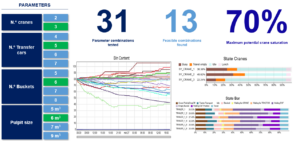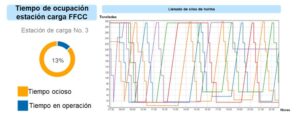CONSULTING
Dynamic simulation: Global logistics and industrial efficiency with advanced simulations
In modern times, the complexity of global logistics has significantly increased. Globalization has expanded supply chains across multiple countries and continents, making them more intricate and interdependent. Technological advancements, while beneficial, also add layers of complexity as companies integrate new systems and processes to stay competitive. Environmental concerns and the push for sustainability require logistics providers to adopt greener practices, adding another dimension to their operations. As a result, managing logistics in the modern age demands innovative solutions and advanced tools to navigate these complexities effectively.
The challenge does not only involve managing big scale logistics. Internal logistics have become quite the challenge for any industrial plant, from scheduling the production of a steel plant up to managing the AGV movements of high-tech warehouses and distribution centers.
In the high-uncertainty scenario of internal and external plant logistics, there is a system to understand and improve any system or process: Dynamic Simulation.
What is Dynamic Simulation?
Dynamic simulations are computer-based modeling processes that allow users to create digital models of business systems to analyze and optimize their performance. Dynamic simulation can be further divided into continuous and discrete event simulations (DES). DESs represent systems as a series of chronological events that cause changes to the state of objects within the system. These events are processed in real-time during a simulation run, enabling users to gather valuable metrics and insights about the system’s behavior and efficiency. This approach is particularly useful for experimenting with different variables and predicting how changes will impact the overall system performance.
Worldwide, there is one outstanding software used as industry standard for optimization through dynamic simulation: FlexSim. It offers a comprehensive library of pre-built simulation objects and customizable controls, allowing users to tailor models to their specific needs. Its data connectivity features enable seamless integration with existing data sources, ensuring that simulations are based on accurate and up-to-date information.
Applications of dynamic simulation in various industries
Dynamic simulation can be utilized in a wide variety of use cases, assisting users to develop and improve their systems as well as those of their clients. It can be particularly valuable in industries such as manufacturing, healthcare, logistics, and supply chain management. By creating detailed simulation models, users can analyze complex processes, identify bottlenecks, and test various scenarios to find optimal solutions. FlexSim’s ability to visualize systems in 3D and its comprehensive library of simulation objects make it easy to build accurate and realistic models.
Some of the most widely used applications for dynamic simulation include:
- Warehouse Management: Simulate warehouse operations to identify inefficiencies and optimize layout, inventory management, and picking processes.
- Manufacturing Flexibility: DES systems can be used to develop strategic planning processes for consolidating manufacturing sites or pooling volumes globally.
- Automated Warehouse Decision Support: Create simulation models of automated warehouses to serve as decision support tools.
- Material Handling Systems: Test changes in material handling systems, such as AS/RS and conveyor loops, to increase throughput and efficiency in warehousing processes.
- High level supply Chain Optimization: Using FlexSim’s Geographic Information System (GIS) module allows a dynamic model can be used for simulating travel routes and logistics networks.
Dynamic simulation (through FlexSim) has become an important tool for IDOM because it enhances their ability to deliver high-quality optimization and production processes evaluaition. By creating detailed simulations of industrial processes, logistics networks, and facility layouts, FlexSim helps IDOM identify inefficiencies and optimize operations. This leads to improved productivity, reduced costs, and enhanced service reliability for their clients. Additionally, FlexSim’s decision support capabilities allow IDOM to test various scenarios and strategies, ensuring that solutions are data-driven and effective.
IDOM in action
Improving the scrap yard of a steel-making plant
IDOM’s Strategy and Operations team developed a logistics feasibility assessment in the steelmaking industry. As part of a production process rearangement, the material requirements for the steel plant changed, which proved to be quite challenging as, among other things, it involved redesigning the scrap yard area. The simulation project aimed to validate the production operations, focusing on the new scrap yard layout and altered material flows due to the production change. After some conversations with the client, the following FlexSim model was created.
Finally, with the model, operations were considered viable, where there was no risk of stock-outs during 1 month of operations. The model allowed the client to explore how operations would change if some equipment was changed: i.e. reducing the number of cranes in operation.
Dynamic simulation was instrumental in modeling the new logistics and material handling processes. The simulation helped identify potential bottlenecks and inefficiencies in the new scrap yard layout, allowing the team to make data-driven decisions to optimize the flow of materials. 31 different scenarios were developed, 13 of which provided the performance and capability required.

Food and beverage production
IDOM has also utilized dynamic simulation to optimize the production at a food and beverages plan, reducing the load cycle time from the 4/5 hours to the objective 3 hours. Besides, the client also wanted to explore the loading and unloading system for the silos of a byproduct. The model took real world loading/unloading parameters and simulated both the main loading cycle and the byproduct management with a truck system.
IDOM found options to maintain the minimum required cycle time by reducing the planned investment as well as possible threats in the charging process. 8 different loading procedure scenarios were tested, which helped the client understand how the process capacity would change.

In both projects, developing a DES was instrumental in modeling the new logistics and material handling processes. The simulation helped identify potential bottlenecks and inefficiencies, allowing the team to make data-driven decisions to optimize the flow of materials. By simulating different scenarios, IDOM was able to provide valuable insights into how the planned changes will affect operation.
Dynamic simulation is slowly becoming one of the most solicited services IDOM has to offer in the logistics consultancy sector and will continue to as logistics process becomes increasingly more challenging.



